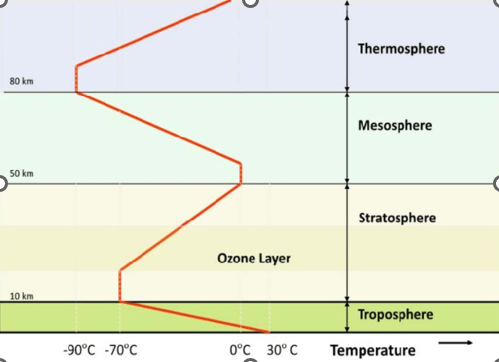A Dynamic Planet: Atmospheric Structure, Dynamics and Global Climate (Lecture 2)
1/15
There's no tags or description
Looks like no tags are added yet.
Name | Mastery | Learn | Test | Matching | Spaced |
|---|
No study sessions yet.
16 Terms
Name the 4 layers of the atmosphere in order from lowest to highest.
Troposphere (0-10km)
Stratosphere (10-50km)
Mesosphere (50-85km)
Thermosphere (85km <)
Name the fixed components of the atmosphere. State their proportions.
78% Nitrogen
21% Oxygen
1% Argon
Name the variable components of the atmosphere. State their proportions.
0-4% Water Vapour
0.01 ppm Ozone at the surface, 10 ppm at 25km altitude
What other particles are present in the atmosphere?
Water droplets and ice - clouds and precipitation
Dust and salt particles - aerosols

Why does the atmosphere have this temperature profile?
Troposphere: relatively warm at the ground with temperature decreasing with height - due to heating from greenhouse effect
Stratopause (boundary between the stratosphere and mesosphere) ~ 50km altitude
is warm due to presence of ozone layer
Ozone reacts with UV which splits it apart – heat produced from the reaction
Mesosphere: temperature decreases with height
Thermosphere: temperature increases with height due to intense radiation from the Sun
O2 and N2 absorb UV and X-rays atomising them
They then absorb radiation ionising them giving out heat
Explain how the Earth maintains radiative equilibrium.
When the incoming solar radiation is balanced by the outgoing thermal radiation.
If more energy is absorbed than emitted, the Earth would heat up, and if more energy is emitted than absorbed, the Earth would cool down
Compare the Earth's atmosphere to those on other terrestrial planets in the Solar System
Mercury:
Very thin atmosphere composed mainly of trace amounts of hydrogen, helium, oxygen, sodium, potassium, and other elements.
Venus:
Thick atmosphere primarily composed of carbon dioxide (CO2), with trace amounts of nitrogen and other gases - creates a strong greenhouse effect
The atmospheric pressure at the surface of Venus is about 92 times that of Earth's, making it extremely dense.
Mars:
Thin atmosphere primarily composed of carbon dioxide (95.3%), with nitrogen, argon, and trace amounts of oxygen and water vapor.
The atmospheric pressure on Mars is only about 0.6% that of Earth's.
Define vapour pressure
The partial pressure of water vapor in the atmosphere (hPa).
Define Dewpoint temperarture
Temperature to which you would have to cool the air to reach saturation (i.e., the temperature at which dew would form).
What is adiabatic cooling?
Adiabatic cooling occurs when the air parcel expands due to decreasing atmospheric pressure as it rises. The expansion leads to a decrease in temperature.
What is adiabatic warming?
Adiabatic warming occurs when the air parcel compresses due to increasing atmospheric pressure as it descends. The compression leads to an increase in temperature.
What does the rate of adiabatic temperature change depend on?
Whether the air parcel is saturated or unsaturated.
Dry adiabatic lapse rate (10⁰C per km) applies to unsaturated air parcels
Moist adiabatic lapse rate (5-8⁰C per km) applies to saturated air parcels
Why is moist adiabatic lapse rate lower then dry adiabatic lapse rate?
Condensation releases latent heat, mitigating the cooling effect
Define saturation of an air parcel
State where the air parcel holds the maximum amount of water vapour possible at a given temperature and pressure without condensing into liquid water or ice
Define latent heat of air parcel
Energy released when water vapour condenses when an air parcel reaches saturation (during cloud formation or precipitation)
Explain the Earth's general circulation.
Earth has 3 cells in each hemisphere that are a part of the Earth’s atmospheric circulation: Hadley cell, Ferrel cell and Polar cell
Hadley cell: converging air rises, produces clouds and then precipitates
Ferrel cell: polar fronts at the surface are associated with a jet stream aloft. The jet streams blow from west to east.
o The jet stream separates polar air from tropical air.
o The jet stream is stronger in the winter hemisphere.
o The jet stream ridges over wide mountain ranges and troughs downstream of them.